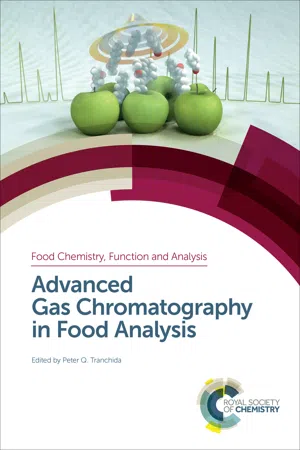![]()
![]()
1.1 Food Analysis and the Volatile Fraction: A General Introduction
The volatile fraction of a food plays a fundamental role in its characterization and its acceptance and appreciation by consumers. In chemical terms, the volatile fraction of a matrix of vegetable origin can be defined as a mixture of volatiles, which can be sampled because of their ability to vaporize spontaneously, and/or under suitable conditions, or by adopting appropriate techniques.1–3 In general, the term volatile fraction is therefore an umbrella term including a group of approaches and/or techniques that produce samples representative of the volatiles characterizing a food matrix, which may have different and mutually non-comparable compositions, however; e.g., headspace, essential oils, aromas, flavors, fragrances and extracts obtained by specific techniques.
In the food field, the volatile fraction plays a fundamental role in the flavor definition of a foodstuff. The concept of flavor involves a holistic description of food perception, as indicated by the International Standards Organization definition.4 According to that definition, flavor is a “complex combination of the olfactory, gustatory and trigeminal sensations perceived during tasting. The flavor may be influenced by tactile, thermal, painful and/or kinesthetic effects”. Flavor, therefore, necessarily entails the involvement of a biological interaction (mainly related to the sensory field) that, for the perception of aroma and taste, is induced by the interaction of bioactive molecules with chemoreceptors located in the nose and on the tongue. The volatile fraction of a food is at the origin of its aroma, which can be defined as that combination of volatiles that can be perceived both orthonasally and retronasally by the odor receptor sites of the smell organ, i.e., the olfactory tissue of the nasal cavity (known as regio olfactoria). Its importance is testified by studies examining crossmodal interaction in actual perception, suggesting that for some foodstuffs up to 80–90% of the taste comes from the nose.5,6
These basic assumptions closely fit the guiding principles of omic sciences, and in particular of metabolomics. This discipline was defined by Oliver et al. in 1998 as the systematic study of the unique chemical metabolite fingerprints (the metabolome) resulting from specific cellular processes.7 However, metabolomics, used in combination with sensory perception, is too general a discipline to fully meet the specific needs of the food field, whose final goal is the objectification of aroma and taste on a molecular basis. This need was met by Schieberle and Hofmann, who, in 2011, introduced “Molecular Sensory Science” or “Sensomics”, a subdiscipline whose aim is to identify key food aroma and taste compounds at the molecular level, and to map the combinatorial code of aroma and taste active key molecules sensed by human chemosensory receptors and integrated by the brain.8,9
The practical fallout of this concept is the so-called flavor blueprint or flavor signature of a food, i.e., the combinatorial code of the entire set of odor- and taste-active food components in their natural concentrations in the food.8,9 Taken together, these definitions make it possible to be in line with the more general goal of omic sciences, i.e., to achieve the so-called higher level of information. This is information in which the chemical data resulting from a research investigation are suitable to describe directly a biological or quality characteristic of the matrix under investigation.
In analytical terms, metabolomics, and thus sensomics, implies the comprehensive and quantitative analysis of the largest possible array of low-molecular-weight components (<1000 Da) in the investigated samples.8,10 In this view, metabolomics have also seen the introduction of dedicated approaches affecting the chemical analysis strategy, which have successfully been transferred to food analysis; the best known are fingerprinting and profiling. Fingerprinting refers to general and rapid high-throughput screenings aiming to discriminate and classify samples; this can also be achieved with a non-separative approach, i.e., headspace–mass spectrometry (HS-MS), direct infusion–MS, nuclear magnetic resonance (NMR), Fourier transform infrared (FT-IR), medium infrared (MIR), near infrared (NIR), etc. combined with suitable statistical data processing. Profiling gives a detailed analytical profile of the sample by combining separative and spectroscopic techniques [e.g., gas chromatography–mass spectrometry (GC-MS), liquid chromatography–mass spectrometry (LC-MS), capillary electrophoresis–mass spectrometry (CE-MS), etc.] in view of identifying and quantifying diagnostic components.11 ...
